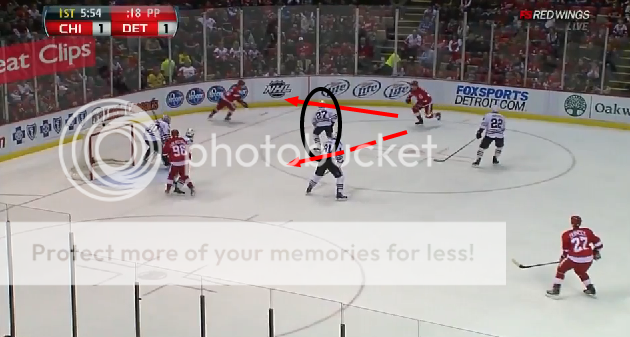Hockey is a game of ebb and flow. It's a natural and integral part of the game. On a micro level it can be seen in the up and down movement on-ice, the fluid transitions from offense to defense and back again. On a macro level, it can be seen in the tendencies of players or teams to get hot or go cold.
The Red Wings are currently laden with a power play that's not just cold, not just slumping, not just ineffective, but is straight up nonexistent. Power play problems began on February 28th against Columbus, a game in which the Wings went 1-for-6 with the man advantage. Since then, they've gone 0-for-24, and including the goal against Columbus they're 1-for-30 over their past seven games.
What's going on? Let's go to the tape.
Hudler carries the puck into the zone, and as two defenders collapse on him he moves the puck to Cleary on the wall.
Cleary sees Hulder turning up ice, which has drawn the near-side defender at the bottom of the box formation towards the corner. Cleary dishes to Hudler and moves towards the corner as well.
The near-side defender's paying attention to Hudler, so Happy Huds makes the smart pass and moves the puck to Cleary down low. Holmstrom is trying to screen, but Emery has moved around him and is tracking Cleary.
Cleary gets a quick shot on net, but Emery is ready for it. Barring a fluky bounce, this puck isn't going in. The goaltender sees it and has a chance to prepare for it, and that's really the antithesis of how shots on a power play should work.
Traffic in front of the net (or lack thereof) was a recurring issue in the film I was able to dig up. It seemed to be about 70-30 in terms of having someone in front of the net versus no one being in Holmstrom's office, and this led to a few slap shots from the point that were easily stopped by opposing netminders. There were also a few times where the situation above played out again. The Wings were able to get pressure deep in the offensive zone (mostly below the box formed by opposing team's defenders) but goaltenders were able to see through screens and stop shots, especially from the side of the net.
This drought can't last forever. All it's going to take is one good point shot or one crisp pass before this thing is at least temporarily buried. In the meantime, spending a little practice time on utilizing netfront screens doesn't seem like a bad idea.
I'd love to hear what other people have to say. Let me know on Twitter @TOGBlog1, by emailing me at theoctopigarden@gmail.com, or by leaving a comment on this post.




No comments:
Post a Comment